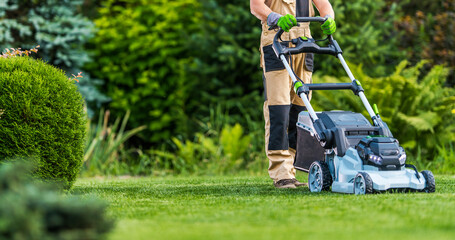A lush, green lawn enhances the beauty, comfort, and value of any property. Beyond aesthetics, a well-maintained lawn contributes to environmental health, provides a safe space for recreation, and improves the overall appeal of a home or business. Effective lawn maintenance requires a combination of proper mowing, fertilization, watering, weed control, and seasonal care. Understanding the principles of lawn care ensures a vibrant, healthy, and durable outdoor space.

The Importance of Lawn Maintenance
Maintaining a lawn is more than a visual investment—it plays a vital role in both property value and environmental quality. Key benefits of lawn maintenance include:
- Enhanced curb appeal – A healthy, well-groomed lawn creates a positive first impression and adds value to a property.
- Erosion prevention – Grass roots stabilize soil, reducing erosion caused by wind or rain.
- Air quality improvement – Lawns absorb carbon dioxide and release oxygen, contributing to cleaner air.
- Temperature regulation – Grass cools surrounding areas, helping to reduce heat in urban and suburban environments.
- Recreational space – Provides a safe and comfortable area for outdoor activities and relaxation.
Proper lawn maintenance is essential to preserve these benefits and ensure a long-lasting, attractive outdoor environment.
Selecting the Right Grass
The foundation of a healthy lawn begins with choosing the appropriate grass type. Factors such as climate, soil, and lawn usage determine the best options:
- Cool-season grasses – Thrive in regions with moderate summers and cold winters. Ideal varieties include fescue, bluegrass, and ryegrass. These grasses grow actively in spring and fall.
- Warm-season grasses – Suitable for hot climates, these grasses grow rapidly in summer and enter dormancy in winter. Common examples are Bermuda, Zoysia, and St. Augustine grass.
- Hybrid grasses – Combining varieties can maximize resilience, drought tolerance, and appearance.
Selecting the right grass ensures optimal growth, durability, and minimal maintenance over time.
Mowing and Lawn Care Practices
Regular mowing is crucial for a healthy lawn. Proper mowing techniques encourage dense growth and maintain visual appeal:
- Correct height – Maintain grass at the recommended height for its type. Cutting too short stresses the grass, while allowing it to grow too long may encourage weeds.
- Sharp blades – Dull mower blades tear grass fibers, causing brown tips and increasing vulnerability to disease.
- Mowing frequency – Remove no more than one-third of the grass height at a time to prevent shock and maintain even growth.
- Mulching – Leaving clippings on the lawn recycles nutrients and reduces the need for additional fertilizers.
Other maintenance practices include regular aeration, soil testing, and overseeding to maintain soil health and encourage strong root development.
Fertilization and Soil Health
Healthy soil is the key to a thriving lawn. Fertilization provides essential nutrients that promote growth and resilience:
- Nitrogen – Supports leaf growth and a vibrant green color.
- Phosphorus – Encourages strong root development.
- Potassium – Improves drought resistance and disease tolerance.
Applying fertilizers according to soil test results ensures optimal nutrient balance. Organic amendments, such as compost, improve soil structure, enhance moisture retention, and promote microbial activity that supports overall lawn health.
Watering Strategies
Proper watering is essential for a healthy lawn. Techniques for efficient irrigation include:
- Deep, infrequent watering – Encourages deep root growth, creating drought-resistant grass.
- Early morning watering – Reduces evaporation and allows grass blades to dry during the day, preventing fungal growth.
- Avoid overwatering – Excess water can lead to root rot, nutrient leaching, and weed proliferation.
- Seasonal adjustment – Modify watering based on weather conditions, rainfall, and seasonal growth patterns.
Efficient watering practices conserve resources while supporting strong, healthy grass.
Weed, Pest, and Disease Management
Weeds, pests, and diseases can threaten lawn health and appearance. Effective management strategies include:
- Weed prevention – Use pre-emergent herbicides during key growth periods to prevent seed germination.
- Targeted treatments – Apply herbicides or natural alternatives to eliminate established weeds without harming grass.
- Pest monitoring – Identify and address insect infestations, such as grubs or chinch bugs, to prevent damage.
- Disease prevention – Avoid overwatering, improve drainage, and remove debris to reduce fungal growth and other lawn diseases.
An integrated approach combining cultural, mechanical, and chemical methods ensures effective long-term control.
Seasonal Lawn Maintenance
Different seasons require specific care to maintain lawn health:
- Spring – Aerate, fertilize, overseed, and prepare the lawn for active growth.
- Summer – Monitor watering, mow consistently, and manage pests and weeds.
- Fall – Fertilize with high-potassium formulas to strengthen roots for winter. Rake leaves and remove debris to prevent mold.
- Winter – Minimize foot traffic on dormant grass and protect against ice or snow damage.
Seasonal attention ensures that lawns remain vibrant and resilient year-round.
Sustainable Lawn Practices
Modern lawn maintenance emphasizes sustainability and environmental responsibility:
- Reduce chemical use – Minimize fertilizers and pesticides by relying on organic options and proper cultural practices.
- Drought-tolerant grass – Select species adapted to local climates to reduce water consumption.
- Composting and mulching – Recycle yard waste to improve soil health and reduce environmental impact.
- Efficient irrigation – Utilize rainwater collection, drip systems, or smart timers to conserve water.
Sustainable practices maintain a healthy lawn while reducing environmental impact and resource use.
Proper lawn maintenance is essential for creating a vibrant, healthy, and functional outdoor space. By selecting the right grass, maintaining soil health, following correct mowing and watering practices, and managing weeds, pests, and diseases, homeowners can enjoy lush, green lawns year-round.
Seasonal care and sustainable practices further enhance lawn health while conserving resources. A well-maintained lawn provides beauty, recreation, and environmental benefits, making it a source of pride and enjoyment. Investing in consistent care ensures a resilient, visually appealing, and long-lasting landscape that elevates the overall quality of any property.